Race, State Violence, and the Possibility of Justice
Lettycia Terrones and Beatriz Esmeralda Maldonado
Often, when we read statistics about the number of people killed at the hands of law enforcement, for instance, in the stories of black and brown people killed by police, or through the systematic elimination of people trapped in the bureaucracies of jails and detention, or in the staggering numbers of mass incarceration in the prison industrial complex, we enact narratives of abstraction. In the numbers, we lose touch with the daily lives and humanity of people who are caged, incapacitated, and/or die at the hands of law enforcement. The overwhelming statistics of those who die prematurely and of those affected by the policies of state-sanctioned policing, often distance our connection to and understanding of people’s lives and, moreover, the political mechanism that structures these forms of elimination. Abstracted numbers—black brown indigenous people killed by police, nameless refugees murdered and disappeared in southwest deserts, criminalized and racially profiled women, the poor, and queer and trans people—further perpetuate erasures of racialized bodies when we consider the multifarious ways in which, as a society, we become complicit with juridical policies sanctioning death at hands of law enforcement. These narratives of erasure normalize a seemingly everyday ordinariness where ubiquitous law enforcement and surveillance—from police on our local streets to militarized national borders, to perpetual war across transglobal geographies—have become part of the social fabric of twenty-first-century life. The hegemony of this narrative of expendability and nonvalue of racialized lives, which perpetuates and operationalizes a norm of state violence, must be challenged.
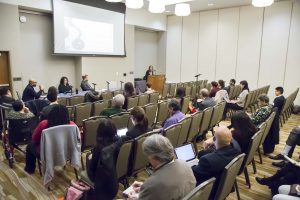
On April 12, 2018, distinguished interdisciplinary scholars at the vanguard of Critical Race and Ethnic Studies research gathered at the University of Illinois at Urbana-Champaign to pose this challenge. They were joined by a packed audience of faculty, students, staff, and community who convened on the occasion of the Illinois 150: The 21st Century University and Research for the Public Good sesquicentennial event. Sponsored by the Department of Latina/Latino Studies and the Office of the Vice Chancellor for Research, the daylong symposium “Death by Policing: Race, State Violence, and the Possibility of Justice,” disrupted the normalization of state violence against racially marginalized people by offering strategies for justice, reparations, and activist refusal against the culture of impunity permeating the violence of law enforcement.
Using interdisciplinary methods including radical feminist study, critical geography, decolonial historiography, and grassroots activist praxis, the guest speakers drew connections between events, stories, and specificities of violence against different racialized groups in order to locate relationships among intersecting coordinates of those targeted for incarceration and elimination at the hands of law enforcement. Woven through three-panel discussions, a keynote lecture, and a closing roundtable, the speakers offered prospects for coalition building to seek an end to systems of over policing. Indeed, the hegemony of dominant narratives of erasure that expound a capitulation to state violence brings into relief the histories of racialized, criminalized, and deviant people who have always resisted, rebelled, and struggled against a state that continues to operationalize and govern the elimination of people. In the words of keynote speaker, Kelly Lytle Hernández, a vision for just and equitable worlds in the U.S. and beyond, where black life, non-white immigrant life, and indigenous sovereignty is possible, can be found in the daily lives of those targeted for elimination through the mechanism of mass incarceration by the state.
Yesterday and Today’s Rebel Archive
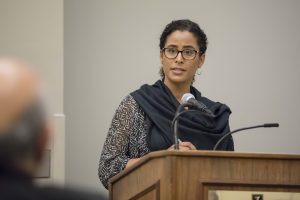
Lytle Hernández put this vision into practice by chronicling the long history of incarceration in Los Angeles, California, which is home to the largest jail system in the United States. Because carceral institutions such as the Los Angeles Police Department have destroyed the majority of official records documenting the history of incarceration, Lytle Hernández’s modes of investigation led her to uncover six stories that evidence Los Angeles’s deep history of policing and imprisonment, including the incarceration of indigenous people from the inception of colonization in the area and the establishment of Catholic missions; the criminalization and jailing of poor white, and often queer, males during the turn of the twentieth century; the racism of anti-Chinese immigration legislation of the late nineteenth century, as well as the deportation and repatriation of Mexican Americans and ethnic immigrants in the early twentieth century, to the rise of targeted incarceration of African American men, also occurring in the early twentieth century which led to the institutionalization of carceral systems in the United States. Lytle Hernández’s historiography uncovers wide-ranging examples of resistance, from artworks to grassroots political organizing, and social justice coalitions that responded directly to meeting social services and community needs. These acts of resistance constitute what Lytle Hernández calls a Rebel Archive. And it is through this past and present Rebel Archive that evidence of peoples’ struggles against western settler colonial logic of elimination through systems of mass incarceration is made visible. Through this archive of rebellion, Lytle Hernández reminds us how since the imperial conquest of the Americas, indigenous, black, and minoritized people have pushed back against domination and fought for dignity and freedom. Lytle Hernandez further described her current project, Million Dollar Hoods, which uses mapping and big data analytics to document the at least six million dollars the Los Angeles Police Department and Los Angeles Sheriff’s Department has spent on incarceration between 2010-2015. Lytle Hernández encouraged all those present to consider how their own research imperatives and projects might also make deposits into today’s Rebel Archive. Indeed, through the course of the day’s sessions, this theme of activist-scholarship ran across the panelists’ presentations, which demonstrated through diverse research projects their commitment to uncovering and telling the stories of those most vulnerable to state violence.
The Rebel Archive constituting these stories of refusal and resistance against state violence at the hands of law enforcement is dynamic. Clearly, the scholarly modes of praxis described in the “Death by Policing” symposium exemplify deposits into a Rebel Archive. The scholarship presented on this day reminded us of Cedric Robinson’s vision in describing humanity’s “inextinguishable resolve to refashion society according to some powerful but imperfect moral vision,” that will bring us closer the prospect of just, equitable worlds built on the collective thriving of the most vulnerable. Thus, we organize this essay thematically to locate each panelists’ contributions to the Rebel Archive as they challenge narratives of (in)visibility, locate the masked apparatus of carceral states and offer rebel interventions that defy state violence and elimination.
Narratives of (In)Visibility
The symposium panels commenced with an immediate problematizing of U.S. media narratives of the police killing of black and brown men by noting how mainstream reporting frequently omits the lives of black, brown, and indigenous women who have died at the hands of law enforcement. Similarly, these erasures also sweep away the lives of indigenous men who statistically are more likely to be killed by police than any other racialized population. Andrea J. Ritchie, Researcher-in-Residence at Barnard College, urged us to counter a culture of impunity which sanctions the criminalization and police violence against racialized lives. We must center our attention to the lives of black women, women of color, transgender women whose deaths by police are erased in the narratives and conversations around racialized death carried out by law enforcement. The names of black women, women of color, and transgender women killed by police are often not discussed in national media channels or academic discourse. Their erasure happens despite often sharing similar circumstances as their black male counterparts. Yet, the stories and circumstances of their deaths by police remain hidden and dismissed under a heteropatriarchy that relegates their deaths to domestic violence and mental illness.
Richie literally put a face to the staggering statistic noting the 700% increase in the incarceration of women in the last four decades. She juxtaposed this statistic with photographs and stories of black, trans, poor, indigenous, and disabled women who have died as a result of racialized policing and its complementary legislation of mass incarceration. Shelley “Treasure” Hillard, for example, was arrested for sex work and minor drug possession. In lieu of incarceration, Hillard was coerced by police to serve as a drug informant. Detroit police did not protect Hilliard’s informant identity and she was found burned and murdered in an act of retaliation. Contextualizing the specificity of Hilliard’s death and lack of concern for her protection by law enforcement, Ritchie connected the revamping of War on Drugs policy under Jeff Sessions to note how an apparatus that criminalizes black and brown people, particularly black women, women of color, and transgender women plays out in their death and incarceration. To invoke visibility and representation, Ritchie stated the names of Erica Garner and Sandra Bland. Erica Garner, the mother of two children and daughter of Eric Garner who was strangled to death by police, died a premature death at the age twenty-seven from a second heart attack. Sandra Bland, who was twenty-eight when she was pulled over in a traffic stop by a police officer who threatened to “light her up,” was found dead three days later hanged in her cell.
Ritchie’s work brought to the fore how police involvement in the lives of black women, women of color, and transgender women often result in death and other forms of violence including sexual assault and imprisonment. Ritchie’s work offered on-the-ground interventions for reducing and eliminating the number of police interactions that can be fatal. Her coalition and policy work, for example, called attention to over-criminalization of young black women in New York City whose arrests or ticketing are likely the result of poverty crimes like failing to pay public transit fair or shoplifting. Her work seeks alternatives to dealing with offenses—ways that do not involve the police. By urging those present at the symposium to locate the intersections of gender, class, immigration status, sexuality, and disability as well as race in our conversation on death by policing, Richie asked what a new paradigm of relationality to each other would look like, where a vision of safety means looking out for those most vulnerable.
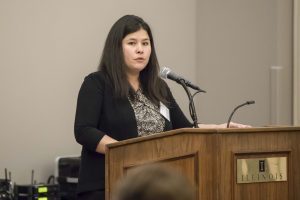
Wendy Vogt, Assistant Professor at Indiana University-Purdue University, Indianapolis, concentrated on migrant deaths in the U.S. and Mexican border. Vogt’s analysis demonstrated how migrant bodies are treated by the U.S. Border Patrol. Migrant bodies not only contend with the geographical space of the Mexican desert, migrants must also navigate legal structures of rights and surveillance. Even more so, Vogt emphasized the commodification of the migrant body through its connection to death and life. Vogt first described the U.S.-Mexico border in order to expand on the surveillance and normalization of violence toward migrant bodies. Vogt stressed that the journey of migration on the border is a location of profit for the U.S. and Mexican state. For one, the Mexican state profits in the context of Mexico’s drug war, forcing many migrants to become payers and using them to sell drugs. Secondly, there is unlawful immigration happening throughout the border, motivating the U.S. to extort and penetrate it for power and enforcement. This cycle of profit and power becomes normalized to the point that there is a systematic profiling of migrant bodies. Such violence against migrants is not randomized. There is a routinized state security, which ultimately makes these enforcement practices normal. Vogt asserted the significance of this normalization of violence. Immigration enforcement is structured to prevent migration flows, but the U.S. patrol officers are abusive in their power to do so. Because these officers can perform with complete impunity from the nation, the state and criminal violence are always present. Such circumstances allow for migrants to be transformed into commodities. Migrants are racialized and become endangered when their bodies are in transit. Vogt reinforced that migrants gain and lose value through their dismemberment and death: to sell, to traffic, to kill—each a form of commodifying the migrant body. Her final words rang powerfully: “Mexico is a cemetery for Central Americans, but without crosses.”
Masked Apparatus of Carceral States
Jordan T. Camp, American Studies Assistant Professor at Barnard College established the historical context for examining the political economy underlying police violence in the United States. Noting Dr. Martin Luther King’s “Riverside Speech,” delivered a year before his assassination, Camp described how King connected U.S. global imperialism and permanent war to the suppression of insurgent struggles against police terror and anti-war organizing in local urban U.S. cities. For Camp, overcoming racism in the U.S. requires attacking its roots in the political economy of racial capitalism and U.S. imperialism. Upon reminding us of King’s description of military forces being deployed to suppress insurgent struggle in Vietnam as being the same as those being deployed on the streets of Watts and Detroit, Camp brought into stark relief the realities of contemporary scenes in U.S. policing. Indeed, the streets of Ferguson and Baltimore are sites of U.S. state militarized deployment to suppress insurrection demanding an end to impunity for the killing of black lives.
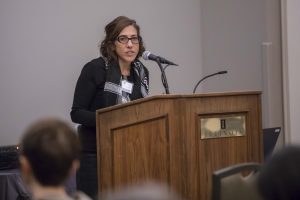
Nadine Naber, Associate Professor at the University of Illinois at Chicago examined the rhetoric of Muslim Ban policies under the Trump Administration by calling attention to Executive Order 13669. Specifically, Naber discussed how terms used in the Executive Order, such as “honor killings,” communicate racist messages implying that America must protect itself against “terrorist foreign nationals.” Naber contextualized the rhetoric of such narratives, suggesting how coded language distracts attention and public critique against U.S. foreign policy and national law enforcement. Naber urged us to find relationships between and across intersections of racialized people experiencing death at the hands of the state. To do this, we must defamiliarize narratives that justify and fund apparatuses of surveillance and militarization of borders under the guise of protecting American purity. The irony of this ideological rhetoric is audacious given the sexualized and homophobic forms of torture that form part of U.S. local and transglobal law enforcement practices. We see this in the widely reported cases of torture from Guantanamo and Abu Ghraib, to local clandestine sites of extraordinary rendition such as the Homan Square blacksite, where over seven thousand people (a majority being people of color) underwent undisclosed interrogations by the Chicago Police. The melding of counterterrorism tactics used abroad to survey, control, and detain those perceived to be Arab and Muslim reminds us that racialized violence and national policing is part of a larger U.S. warfare state. Naber encouraged scholars to develop research imperatives to seek justice for the lives of those impacted by violent law enforcement. For instance, we must interrogate links between researchers and federally funded programs. We must be critical of research developments that support the militarization of the police. To ensure healthy political discourse and protest against state repression, we must be vigilant against the rise of racial profiling in surveillance and networked data collection practices across local, national, and transglobal spaces.
Jenna Loyd, Assistant Professor at the University of Wisconsin, focused on migration, legal status, and policies. When it came to the United States, Loyd emphasized the compliance of the country in allowing disappearances and killings of asylum seekers in Europe, Africa, and Australia. In 1994, the U.S. Border Patrol developed their own strategic plan toward migrants entering the country. This strategic plan, called Prevention Through Deterrence, earned vigorous criticism because it redirected migrants into treacherous environments, with dangerous conditions in transit. These deterrence efforts depended on anti-Black and anti-Latinx racism, which then also influenced the politics of addressing migrants’ legal statuses. Loyd then moved on to the refugee relocation effort, Operation Safe Haven, in Panama. She mentioned the Cuban residents at the location that claimed that “this is paradise, Guantanamo was hell.” In addition to Cuban residents, Loyd also mentioned the treatment of Haitians. Loyd highlights how the United States Immigration and Naturalization Service (INS) and State Department worked together to deter all asylum requests from Haiti. Originally, this safe haven was intended as a departure from the past history of deterrence, yet elements of such deterrent measures manifested this so-called “haven.” For instance, elements of deterrence created conditions of impunity within the state for United States government officials. Additionally, the state did not approach these refugees as asylum seekers, but rather as economic migrants instead. Therefore, “safe haven” served as a euphemistic term of deterrence; safe haven was another mechanism of death by policing and a strategic erasure of Haitians. Loyd finalized her talk by declaring that the end of death by policing will be achieved by ending U.S. imperialism. Loyd asserted that asylum seekers deserve the opportunity to find safety and create healing for themselves.
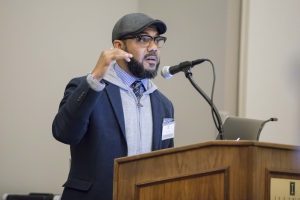
John M. Eason, Associate Professor at Texas A&M University, focused on migrant deaths that occurred while in Immigration and Customs Enforcement (ICE) custody in detention centers and facilities. His research question encompassed the following—“What are the conditions of this facility that lead to deaths and suicides and what are the institutions concealing about these deaths?” To investigate this question, Eason shared his methods and discussed accessibility to information. He was critical of the representation of these deaths: there is a systematic erasure happening that contributes to a lack of public familiarity with these deaths. Eason explained his investigation of “punitive capacity.” For Eason, investigating punitive capacity in ICE detentions and facilities means accounting for the management of physical and emotional control over migrants. His investigation centers on what conditions impacting migrants may lead to deaths and suicides. The institutions of detention uphold inhospitable conditions, placing migrants in an environment conducive to choosing self-deportation. Eason underlines the high predictability of death in these centers, which range from attempted suicides to untreated illnesses. Moreover, private detention facilities do not provide medical care. No one is legally responsible for the life and death of a migrant, apparent in the lack of accountability in these immigration detention centers. Therefore, migrants are left in legal limbo.
On this note of legal limbo, Eason describes the story of Raul Morales. In his filed grievances, Morales states: “To who receives this…I am letting you know that I am very sick, and they don’t care for me…I only need medical attention…to whoever is in charge of receiving these complaints, I am letting you know I am very sick…” Before dying, Morales was transferred from a detention facility to a local hospital. He had filed those grievances but did not receive immediate care or attention. Eason ended his talk by addressing how even though punitive measures vary across facilities, the average detainee is consistently subjected to violence (as in the Morales case). Eason pushed for a new correctional discourse that advocated for humanitarianism and accountability.
Rebel Interventions Against State Violence and Elimination
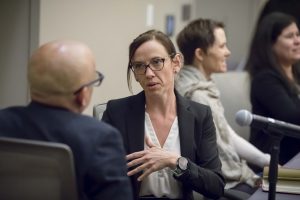
Robin Reineke, Research Social Scientist at the University of Arizona, investigated missing bodies and disappearances that occur upon traversing the U.S.-Mexico Border. Reineke determined such disappearances as another form of death by policing. In her analysis comparing disappearances and death by policing, Reineke explored the absence of state care and accountability. Throughout her investigation, she acknowledged the necessary discourses on personhood and individuality with respect to a disappeared member, noting the involvement of the state, the care and support from families, and the undistinguishable existence of the disappeared member. Reineke shared her role as a co-founder of The Colibrí Center for Human Rights. That organization’s members meet with families in their attempts to access information and truth without involving law enforcement. Reineke detailed the case of a specific disappeared person: Nancy Cordova. Cordova was from Peru, and she had journeyed by bus to reach Northern Mexico. In her travels, she attempted to cross the U.S.-Mexico border but had suddenly disappeared. Reineke admitted that the language of the disappearance is weird. Even as she interacted with communities, it is physically impossible to demonstrate power and protection for a person who is not tangibly present. Despite this, Reineke argued that the status of the disappeared is always political: immigration enforcement officials will never willingly advocate for the families of the disappeared, much less for the disappeared themselves. The consulates of both countries, Mexico and the United States, are equally unsupportive of disappeared cases. There is so much marginalization taking place that the lack of accountability and accessibility further reinforces other forms of death by policing through surveillance and power.
Referring back to Nancy Cordova’s story, Reineke revealed the privilege and opportunity of Cordova’s family to participate in the journey of finding her body. Not all families have this opportunity to be mobile and directly active in the search for a disappeared body. Using the resources of DNA collection from the Colibrí Center, Reineke and Cordova’s family were successful in locating Cordova’s remains. Before this moment, Reineke had mentioned how Cordova’s daughter claimed that “I only feel alive when I’m searching for her.” This daughter’s life was very much defined by the disappeared. This moment of searching for and finding the mother was crucial for Cordova’s family. Reineke shared that there was also a blessing ceremony with participants from interfaith community members. With this special remembrance, there was a process of mourning that couldn’t be completed before, organized by a community meaningful to the family. Reineke concluded by exposing the causes of disappearances: the state of origin; prevention through deterrence; government programs that persecute undocumented migrants who attempt to cross U.S. borders; coyotes in the crossing; border patrol tactics; consulates; border patrol and families attempting to file reports; those seeking to financially exploit families; the Federal Bureau of Investigation and the National Institute of Justice; academics; press and media; elected officials; and, the historical archive itself. To Reineke, these causes are a call to action for academics and activist members to evaluate their positionalities and contributions to the counter-narratives of these discreet forms of death by policing.

Monica Muñoz Martinez, Assistant Professor at Brown University, contributes to this work by recovering the history of anti-Mexican violence in Texas. Tracing the legacy of vigilantism in Texas at the hand of law enforcement like the Texas Rangers, Martinez unfolds how a culture of violence becomes systematized, and calcifies in a culture of impunity to normalize conditions of brutal racist violence. Martinez described how Mexican families in Texas have historically resisted state-sanctioned violence. Resistance has happened both in the immediate aftermath of lynchings of Mexicans in the early twentieth century and continues today in non-profit projects. For example, Refusing to Forget is a multifaceted project which memorializes the history of racialized violence experienced by Mexicans. The project documents this struggle through museum and online exhibits, historical marker unveilings, collecting family histories, and circulating curricular materials for teachers to reckon with the long history of violence in Texas. Their work contextualizes the contemporary climate of militarized border violence. Moreover, Martinez’s work in the Mapping Police Violence project further exemplifies how interdisciplinary research technologies including GIS mapping and historiography offer materials support to community-based efforts to recuperate and make visible histories of resistance and defiance of state violence.
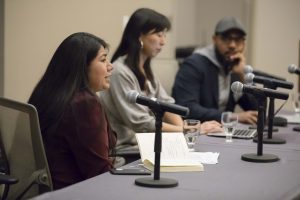
Angelica Camacho, Postdoctoral Fellow at the University of Illinois at Urbana-Champaign, addressed the Pelican Bay State Prison and its conditions of confinement. The inmates’ existences majorly pertain to the cell, where the question of “Who you are assumed to be?” ends up being the consequence of their imprisonment. The model of control, mental imprisonment, and physical violence remains omnipresent in the prison. A violence which is external to the entire prison becomes an internalized form of existence for these incarcerated members. Camacho noted the development of distress among the inmates: extreme forms of paranoia, panic attacks, and self-mutilation. Camacho referred to a specific case: Alex Machado. Machado had committed suicide in the prison, leaving a single note behind: “I love you Jesus Christ, and I love you God, my family, and all that I know. Love, Alex.” Camacho highlighted the warning signs that lead up to Machado’s death. He had demonstrated signs of paranoia and sleep anxiety, he felt like he was being watched and listened to all the time, and he claimed to have heard voices as though somebody was controlling his thoughts.
The isolation in the prison had the potential to lead an inmate toward self-destruction. Even more so, the Pelican Bay officials worked to maintain control of the prison facilities in order to continue the project of expansion and power. Camacho later notes what happens after an inmate has been released from the prison. She described how inmates have internalized incapacitation from the prison, which forces the inmates to relearn their environments as they are released. Ultimately, Camacho reiterated the impact of families sharing their stories, especially as their invested support in their imprisoned members is significant. For Camacho, sharing family stories of commitment and support is a form of activism that functions as a push for change and reveals the power of a united and collective group.
Conclusion
The symposium, “Death by Policing: Race, State Violence, and the Possibility of Justice” brought interdisciplinary scholars to the forefront of engaging with, challenging, and resisting state violence; erasure of underrepresented communities; and power dynamics within archives. They touched on the impact of documentation, the production of histories, and the development and limitations of representations. They contested with the normalization of death and the ways in which infiltration of space transcends the local into the national and worldwide. They grappled with modes of exploitation, questioning the regimes of justice and the potentialities that accompany it. The diversity of scholarship allowed for multiple interventions, from abolishing the police state to interventions that seek traditional systems of recognition. They urged the need to reevaluate narratives of (in)visibility, the masked apparatuses of carceral states, and rebel interventions against state violence and elimination. These scholars honored notions of the collective, for this reality of death by policing is an issue charged for future scholarship and praxis intervention.


